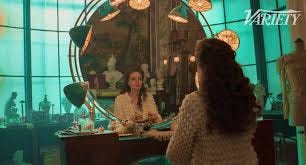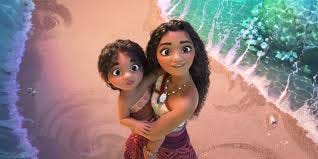Following in the footsteps of Jackie and Spencer, Maria once again finds filmmaker Pablo Larrain taking one of the most famous women of the 20th century and creating a cinematic mosaic designed to explore the nuances and pressures of living their lives in the public eye during a period of intense public scrutiny in order to let their voices be heard in ways that they were not often allowed to at the time and, perhaps more importantly, allow someone the chance at an almost sure-fire Oscar nomination for Best Actress. The difference this time is that unlike Jackie Kennedy and Princess Di, his subject here, opera icon Maria Callas, was, of course, most famous for her soaring voice, not to mention her tempestuous love affairs, most notably with Greek shipping magnate Aristotle Onassis. Set over the course of the last few days of her life before her death in 1977, the film finds Callas (Angelina Jolie) rambling around her Paris apartment in a pill-induced fog, ordering her staff about while contemplating the notion of making a return to performing after a long absence from the stage. Most of her time, however, is dedicated to looking back and relitigating her past—from her dark childhood in Athens in which she and her sister were essentially pimped out to Nazi officers by their mother, to her stunning musical career to her affair with Onassis (Haluk Bilginer)—under the urging of a visiting reporter (Kodi Smit-McPhee) who has been allowed a peek behind the curtain of her life. Of course, since the reporter’s name, Mandrax, also happens to be the same as her prescription drug of choice, there is just the slightest chance that he may not actually exist and that what is transpiring is mostly occurring in her mind as she is contemplating the end of what was by all accounts an extraordinary life—this also presumably explains more fantastical moments as a crowd in the streets of Paris suddenly bursting into a rendition of the Anvil Chorus from Il Trovatore while she muses that she no longer felt the need to perform because she believed that the city was in fact performing for her.
In interviews, Larrain has suggested that Maria will be the last of these biopic portraits of famous women and considering the fact that it is by far the least of them, that is probably a good idea. Although not without their flaws, Jackie and Spencer at least seemed interested in their respective subjects and had some intriguing ideas about what the lives of those women meant to the world at large as well as to themselves. By comparison, neither Larrain nor screenwriter Stephen Knight (who also wrote Spencer) seem to have much interest or curiosity in Callas, either as a person or as an artist, beyond the most obvious points, and the conceit of bringing in an interviewer to guide her through the key points of her life is both lazy and clumsily handled. Befitting the musical form at its center, Larrain tries to give Callas’s story an operatic feel to it through its bold visual style but while it certainly looks good, it doesn’t quite cover up the fact that he doesn’t really have much to say about Callas other than “Man, those famous women are sure complicated, aren’t they?”—it makes you yearn for the good old days of those whackadoodle musical biopics that Ken Russell used to crank out in the Seventies that, for all their wildness and lack of adherence to reality, at least were never boring. As for the Jolie performance at its center, it is technically fine and will no doubt earn her all sorts of accolades but at its heart, it lacks the kind of fire that one might expect to see, both from the normally electrifying actress and from anyone daring to portray Callas. (The closest the film gets to that comes from Valeria Golino, who pops up for a brief but memorable scene as Callas’s sister.) The music, of course, is spectacular (the film uses recordings of Callas herself throughout, mixing in Jolie’s own voice for some of the present-day scenes where she is attempting to reconnect with her gifts) but in a way, even this aspect winds up working against Maria—to hear the passion, excitement and artistic fever on full display in those recordings only serves to highlight just how absent those qualities are in the rest of the film
.Set three years after the adventures chronicled in its predecessor, Moana 2 opens with our heroine (Auli’i Cravalho) busy sailing out to new islands in the hopes of one day discovering other tribes that she is convinced are out there somewhere. After discovering an artifact suggesting the presence of others, she has a revelation from her ancestors telling of an island that once served as a nexus for numerous tribes scattered across the ocean that was sunk to the bottom of the sea and cursed by the spiteful god Nalo. This naturally leads her to go out on a quest to find the location of this missing island and break Nalo’s curse so that it may rise from the depths once again and hopefully bring the other islands back together into a shared community. Aiding her on this journey are three members of her tribe—a would-be storyteller, a spunky inventor and a cranky farmer—and along the way, they also acquire both a member of that oddball Kakamora tribe of sea pirates that proved to be one of the high points of the first film as well as goofy demigod Maui (Dwayne Johnson), all of who prove to be useful when it comes to their final confrontation with the awesome powers of Nalo.
Moana 2 was initially conceived as a limited streaming series for Disney+ and only at the last minute was it decided to rework it as a feature film instead. That definitely tracks because, for the most part, it does have the feel of a TV special whipped together to capitalize on the popularity of the original film and to feed audience interest before a proper sequel could be made. Like most sequels, this is a film that never quite manages to make a case for its own existence as anything other than a sure-fire cash cow designed to take advantage of the genuine love that audiences have continued to hold towards its predecessor. While that one gave us a fascinating and likable character and took us on her journey of self-discovery that concluded on a hugely satisfying note, this one doesn’t really have any ideas of what to do with her now and is content to essentially recycle the previous film’s key story beats without bringing anything new to the proceedings other than a new cast of supporting characters who remain largely superfluous throughout and a number of intensely forgettable songs. There are a couple of pleasurable elements here and there—the voice turn from Cravalho is still a delight and the sequence in which Moana and Co. battle a giant clam is fun—and it has enough color, excitement and slapstick humor to amuse viewers who are perhaps a bit too young for Wicked and not nearly cretinous enough to deserve the likes of Red One but anyone falling outside of those parameters are likely to find the whole endeavor to be fairly pointless. FYI—the end credits do include an additional scene that seems to point the way towards an eventual Moana 3. If that does get made, here is hoping that it results in a story far more worthy of its main character than this one.





